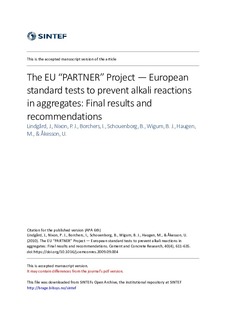| dc.contributor.author | Lindgård, Jan | |
| dc.contributor.author | Nixon, Philip J | |
| dc.contributor.author | Borchers, Ingmar | |
| dc.contributor.author | Schouenborg, Björn | |
| dc.contributor.author | Wigum, Børge Johannes | |
| dc.contributor.author | Haugen, Marit | |
| dc.contributor.author | Akesson, Urban | |
| dc.date.accessioned | 2018-06-20T12:19:20Z | |
| dc.date.available | 2018-06-20T12:19:20Z | |
| dc.date.created | 2010-06-23T12:38:47Z | |
| dc.date.issued | 2010 | |
| dc.identifier.citation | Cement and Concrete Research. 2010, 40 (4), 611-635. | nb_NO |
| dc.identifier.issn | 0008-8846 | |
| dc.identifier.uri | http://hdl.handle.net/11250/2502329 | |
| dc.description.abstract | This paper presents the main findings in the EU PARTNER Project (2002–2006) providing the basis for a unified European test approach for evaluating the potential alkali-reactivity of aggregates. The project evaluated the tests developed by RILEM and some regional tests for their suitability for use with the wide variety of aggregates and geological types found across Europe. The project had 24 partners from 14 countries, covering most of Europe, from Iceland to Greece. 22 different types of aggregates from 10 different European countries were evaluated. It was found that in most cases the RILEM tests could successfully identify the reactivity of the aggregates tested. They were most successful with normally reactive and non-reactive aggregates, but with aggregates that react very slowly an extended test period may be necessary for some of the RILEM methods. Overall, the accelerated mortar bar test and the accelerated concrete prism test seemed most effective and to have the best precision. | nb_NO |
| dc.language.iso | eng | nb_NO |
| dc.publisher | Elsevier | nb_NO |
| dc.rights | Attribution-NonCommercial-NoDerivatives 4.0 Internasjonal | * |
| dc.rights.uri | http://creativecommons.org/licenses/by-nc-nd/4.0/deed.no | * |
| dc.subject | Aggregate | nb_NO |
| dc.subject | Alkali-silica reactions | nb_NO |
| dc.subject | Test methods | nb_NO |
| dc.title | The EU "PARTNER" Project - European standard tests to prevent alkali reactions in aggregates: Final results and recommendations | nb_NO |
| dc.type | Journal article | nb_NO |
| dc.type | Peer reviewed | nb_NO |
| dc.description.version | acceptedVersion | nb_NO |
| dc.rights.holder | © 2010 Elsevier. All rights reserved. This is the authors' accepted and refereed manuscript to the article, post-print. Released with a Creative Commons Attribution Non-Commercial No Derivatives License. The final publication is available at https://doi.org/10.1016/j.cemconres.2009.09.004 | nb_NO |
| dc.source.pagenumber | 611-635 | nb_NO |
| dc.source.volume | 40 | nb_NO |
| dc.source.journal | Cement and Concrete Research | nb_NO |
| dc.source.issue | 4 | nb_NO |
| dc.identifier.doi | 10.1016/j.cemconres.2009.09.004 | |
| dc.identifier.cristin | 340386 | |
| dc.relation.project | Norges forskningsråd: 174878 | nb_NO |
| cristin.unitcode | 7401,30,40,0 | |
| cristin.unitcode | 7401,0,0,0 | |
| cristin.unitname | Arkitektur, byggematerialer og konstruksjoner | |
| cristin.unitname | Stiftelsen SINTEF | |
| cristin.ispublished | true | |
| cristin.fulltext | postprint | |
| cristin.qualitycode | 2 | |

